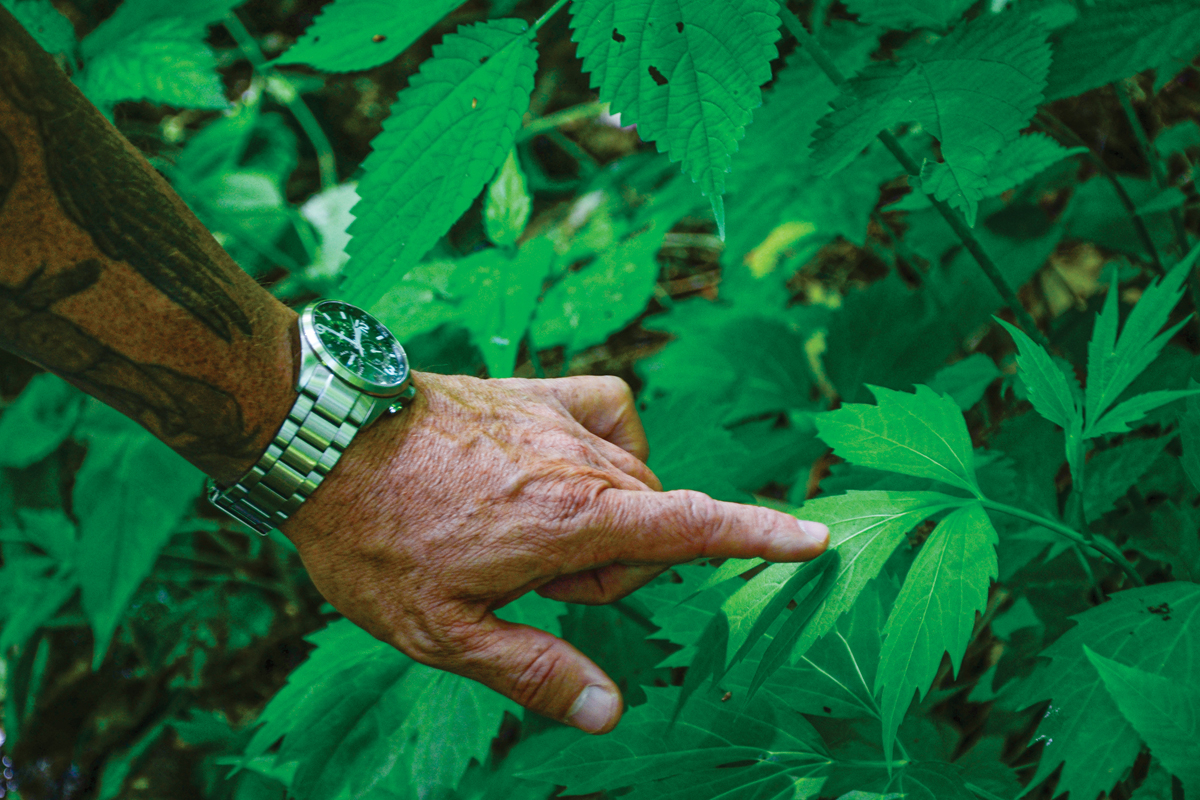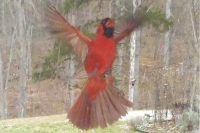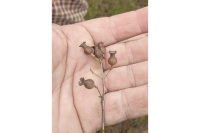Word from the Smokies: Sochan gathering program grows relationship between tribe, park and plants
 Eastern Band of Cherokee Indians Forest Resource Specialist and tribal member Tommy Cabe points to the “turkey foot” portion of the sochan plant, which is harvested and eaten after being blanched and fried. Photo provided by Smokies Life, Holly Kays.
Eastern Band of Cherokee Indians Forest Resource Specialist and tribal member Tommy Cabe points to the “turkey foot” portion of the sochan plant, which is harvested and eaten after being blanched and fried. Photo provided by Smokies Life, Holly Kays.
“There’s some legends and stories about this particular area, this place we’re at right now,” said Tommy Cabe, who is the forest resource specialist for the Eastern Band of Cherokee Indians and a member of the Tribe, looking out over the vibrantly green forest floor surrounding a tiny stream that flows across Chimney Tops Trail.
The same could be said of locations throughout Great Smoky Mountains National Park, a stunning landscape that has been home to Cherokee people for countless generations, long before the park was created and before the first European sailor ever made berth in North America. As the colonial era unfolded and the United States of America was established on land already occupied by diverse native nations, European colonists and the U.S. government pushed the Cherokee onto ever-smaller pieces of their original territory until 1838, when the US Army commenced a campaign to forcibly gather and remove Cherokee people to Oklahoma on the deadly Trail of Tears. Still, some Cherokee people escaped removal or managed to return. Today their ancestors, now known as the Eastern Band of Cherokee Indians, occupy a remnant of the original territory adjacent to the park’s southeastern boundary.
That history has imbued many tribal members with a well-earned distrust of the federal government. But a historic partnership between the Tribe and the park, now in its sixth year, is helping to heal those wounds. In 2019, the two parties signed an agreement to issue tribal members permits to gather sochan (Rudbeckia laciniata), a culturally and nutritionally important native plant also known as cutleaf coneflower or green-headed coneflower. Five years later, both the Tribe and the National Park Service are calling the program a success.
“I’m really thankful that finally the Department of Agriculture and Department of Interior are starting to understand and listen to Indigenous cultures and create these opportunities for Indigenous people to showcase some of their traditional models and merge some of that traditional knowing into science,” Cabe said.
Under the agreement, tribal members can apply for a permit to harvest up to one bushel of sochan leaves per week — for personal consumption only, no selling — during the spring harvest season. Harvesters use a bright orange tote bag to gather leaves and may, with some exceptions, collect them within 328 feet (100 meters) of any official park trail or road. Afterward, they fill out a form that reports how much they gathered and from where. Later in the season, park service staff return to these gathering sites to assess how the harvest impacted the plants’ health.
“The results of that have all been positive,” said Tom Remaley, inventory and monitoring branch chief for the park. “We have seen no difference between the sites that are gathered and the ones we have in our control plots.”
Related Items
This data has led to some changes in the program. The 2019 agreement was good for five years, so this year the harvest continues under an updated five-year agreement. The harvest season has shifted forward — it now runs May 15 to June 30, as opposed to March 1 through May 31 initially — the number of permits has increased from 36 to 50, and less intensive monitoring is required.
Sochan, a relatively common plant in the park, occupies a special place in Cherokee culture. The young shoots are some of the first green plants to come up in the spring. Cherokee harvesters gather only these new leaflets, emerging from the top of the stalk, and separate them from the stem with the flick of a thumb. Cabe usually lets his thumbnail grow a bit longer than usual in preparation for a gathering trip. The harvested leaves are then blanched and fried in animal fat. In the days before refrigeration and stocked grocery stores, those nutrient-packed leaves were a welcome source of nourishment after a long winter.

The lush forests within Great Smoky Mountains National Park, like this one through which Eastern Band of Cherokee Indians Forest Resource Specialist and tribal member Tommy Cabe walks, contain a diverse assemblage of plants that Cherokee people have long used for food and medicine. Photo provided by Smokies Life, Holly Kays.
But to Cabe, these plants are more than just food.
“These are our non-human relatives,” he said. “These are a part of us.”
Interaction with the landscape that nurtured his people is a spiritual experience, Cabe said, and existing within that landscape is about relationship, not conquest. On every gathering trip, he holds a ceremony to thank the plants for their provision before collecting a single leaf of sochan. Though he has chosen not to gather during this trip to Chimney Tops Trail, he still brought along a tobacco pouch “to honor this relationship and this opportunity.”
Sochan doesn’t grow in isolation. Against the burbling of a small stream, Cabe points out the other plants with which it shares this patch of earth — stinging nettle, blackberries, black cohosh, Solomon’s seal.
“Right here, you’ve got a pharmacy,” he said.
Cabe is appreciative of the trust now building between the Tribe and the park service, and he hopes to see tribal members someday have access to even more of this woodland pharmacy. In a few years, the coveted wild onions known as ramps (Allium tricoccum) might join sochan on the list of plants for which tribal members can receive gathering permits. When the Tribe first made the request that led to the 2019 agreement, it asked the park service to approve gathering for both sochan and ramps, but the park decided to pursue sochan first. Ramps are much less common in the park, and poaching is a problem.
“We also didn’t have a lot of data on the extent of the populations,” Remaley said. “We needed to do a little internal data gathering for that, so we put that one on pause.”
The park service has been collaborating with the Forest Service to study harvest plots on both tribal and Forest Service lands, gauging how harvesting impacts these populations when the traditional Cherokee method — cutting the bulb rather than pulling it out — is used. Early results this year indicate traditional harvest might be sustainable, and now the park service has started a new research project to more closely evaluate how harvest might impact populations in the Smokies. Tribal members working under research permits are conducting a traditional harvest on these research plots, for which researchers previously collected baseline data. Study results are expected in two or three years; a ramp-gathering agreement could follow.
Before European settlement, Cherokee people maintained a close relationship with the land now called Great Smoky Mountains National Park that included cutting trees, gathering plants, and using fire—an active, hands-on approach with the land’s long-term health in mind. Restoring access for tribal members to nurture this ongoing traditional connection is the most important outcome of these gathering agreements, Remaley said, “but the second most important thing to me is to really foster a relationship between the park and the Tribe. Just working together, being out in the field together, talking and getting their perspective has been a really positive experience for both of us.”

Eastern Band of Cherokee Indians Forest Resource Specialist and tribal member Tommy Cabe discusses the importance of sochan in Cherokee culture and the relationship tribal members maintain with the plant. Photo provided by Smokies Life, Holly Kays.
For Cabe, it’s vital that relationship is not limited to people with official tribal government positions like his. In the Cherokee community, everybody has something to contribute.
“There are people in our culture who have their ‘PhDs’ in being Cherokee,” he said. “They have a knowing about these plants that will never get taught in the academic world. That still exists in our community.”
That kind of knowledge can help ensure better stewardship of this unique landscape, and preservation of Native gathering practices, for generations to come.
Holly Kays is the lead writer for the 29,000-member Smokies Life, a nonprofit dedicated to supporting the scientific, historical, and interpretive activities of Great Smoky Mountains National Park by providing educational products and services such as this column. Learn more at SmokiesLife.org or reach the author at This email address is being protected from spambots. You need JavaScript enabled to view it..













